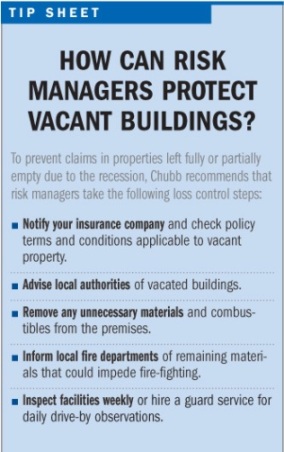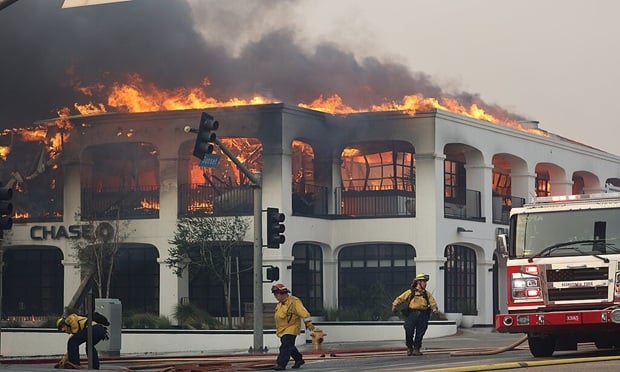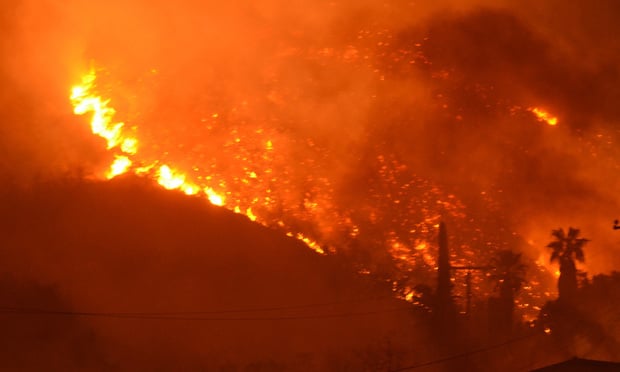Thanks to millions of jobs lost and thousands of facilities shut down due to the recession, empty or partially vacant buildings are becoming increasingly common in both urban and suburban communities, with office vacancy rates in most cities exceeding 10 percent–projected to rise to 16.7 percent in 2009.
Compared to the multitude of risks that come along with managing a fully functioning commercial building, the logical thinking is that a vacant property would present substantially fewer hazards.
After all, in an unoccupied shopping center or office building with no traffic from employees, customers or other daily occupants, there is no one to slip on a wet floor and sue the building owner, or leave the office coffeemaker on over the weekend and start an electrical fire.
Vacant properties, however, are susceptible to a unique set of hazards that must be managed effectively to avoid costly losses at a time when money is already tight for building owners. While these buildings may be unoccupied, they by no means should be left unattended.
The following risks, while varying in severity according to each individual case, should be evaluated regularly when a building sits vacant to avoid potentially costly losses.
o Undetected Damages:
In the day-to-day activities of a functioning office, retail or industrial property, small hazards like an exposed electrical wire or a slow water leak are regularly detected and repaired before they can escalate and cause a loss.
But when the everyday functions are removed from an office building or retail property, the “little things” are less likely to be corrected in a timely fashion and can quickly snowball into much larger problems.
For example, studies by the National Fire Protection Association show that an average of 14,900 fires a year occur in vacant buildings, causing upward of $118 million annually in direct property damage.
Other damage occurs gradually as a building remains abandoned over time.
Mold is a major problem in buildings where water seeps in or an air conditioning unit malfunctions. According to the Environmental Protection Agency, mold can grow on any organic substance including wood, paper, carpet and insulation. When moisture accumulates in buildings or on building materials, mold growth will often occur, particularly if the moisture problem remains undiscovered or unaddressed.
To mitigate the risks presented by these hazards, it's a good idea to have someone conduct a regular “walk-through” of properties not in use. Just make sure the person doing this job recognizes potential hazards and knows enough about them not to risk their personal safety in the process.
o Crime and Liability Risks:
When tenants move out of a building, property owners may be tempted to cut down on security or surveillance efforts to reduce costs–particularly if they are suffering financially. Owners need to keep in mind, however, that they can be held liable for criminal activities or accidents that take place on the premises.
Vacant properties may attract trespassers, arsonists, thieves or other criminals. It's important therefore to maintain a security presence–either on-site or via surveillance–to minimize trespassing and other criminal activities.
o Environmental Red Flags:
Particularly in the case of industrial properties, building owners need to consider the environmental issues associated with vacant buildings.
For example, it must be ensured that a facility used to store chemicals or other pollutants on-site have had these materials either removed or adequately stored to prevent leaks or seepage.
Building owners may be held liable for cleanup should hazardous materials contaminate nearby groundwater or natural resources–this includes local wildlife, which are protected within this category.
Businesses especially vulnerable to this type of risk include manufacturers, dry cleaners and medical facilities.

While above-ground pollutant storage is a major concern, underground storage tanks may represent an even bigger threat to the environment–and the property owner. A fuel tank or other type of holding tank buried underground can corrode over time and therefore must be regularly checked to prevent groundwater contamination.
Fuel tank cleanup and/or removal can be highly expensive. While a small tank may cost a property owner about $20,000, the damage can rise to $15 million for a large tank. To mitigate environmental liability risks, have a professional evaluate the site for pollution, dispose of any waste properly and conduct yearly pressure tests on underground tanks.
In this economy, particularly the real estate sector, financial losses are especially tough to take. A building sitting empty is already costing its owner by way of not producing income. What's more, ignoring the risks listed above may raise those costs even more.
Risk managers who know how to avoid losses in vacant properties will not only avoid costly incidents but will be better prepared to resume normal activities when the time comes.
Timothy Ehrhart is a vice president with Chubb & Son and worldwide underwriting manager for Chubb's commercial insurance real estate industry segment. He can be reached at [email protected].
Want to continue reading?
Become a Free PropertyCasualty360 Digital Reader
Your access to unlimited PropertyCasualty360 content isn’t changing.
Once you are an ALM digital member, you’ll receive:
- Breaking insurance news and analysis, on-site and via our newsletters and custom alerts
- Weekly Insurance Speak podcast featuring exclusive interviews with industry leaders
- Educational webcasts, white papers, and ebooks from industry thought leaders
- Critical converage of the employee benefits and financial advisory markets on our other ALM sites, BenefitsPRO and ThinkAdvisor
Already have an account? Sign In Now
© 2025 ALM Global, LLC, All Rights Reserved. Request academic re-use from www.copyright.com. All other uses, submit a request to [email protected]. For more information visit Asset & Logo Licensing.








